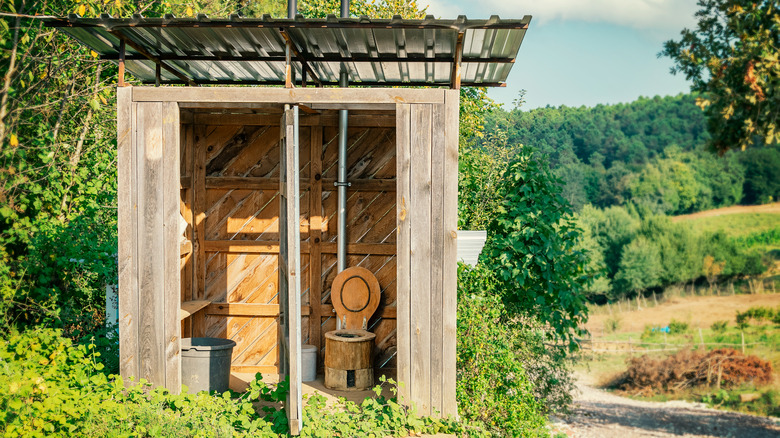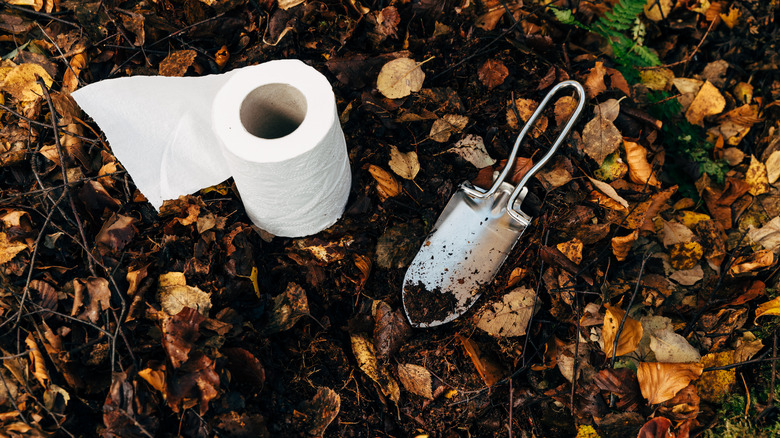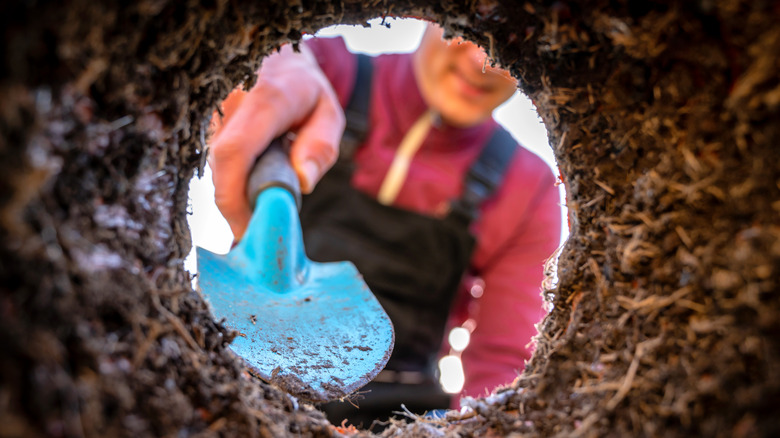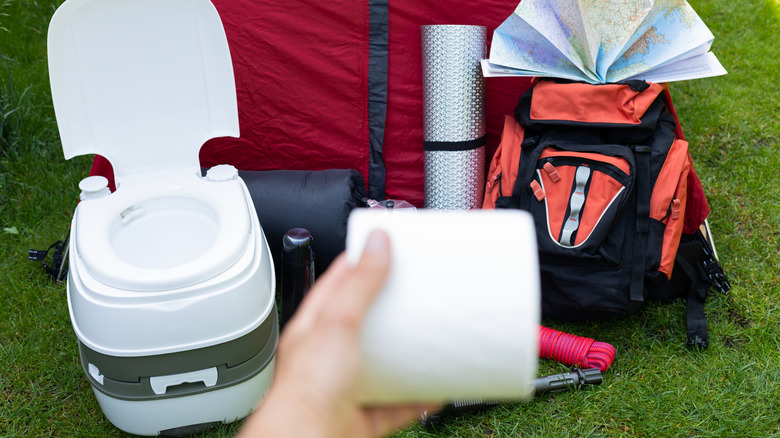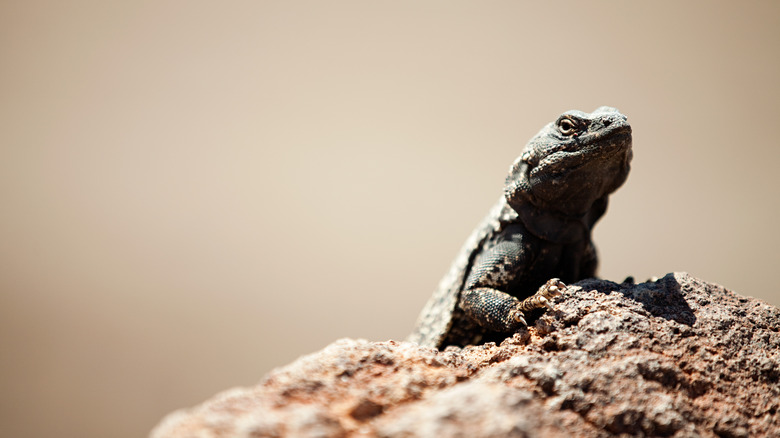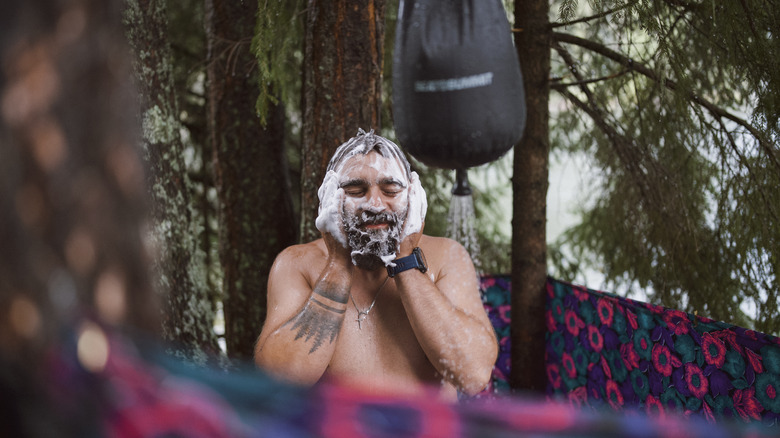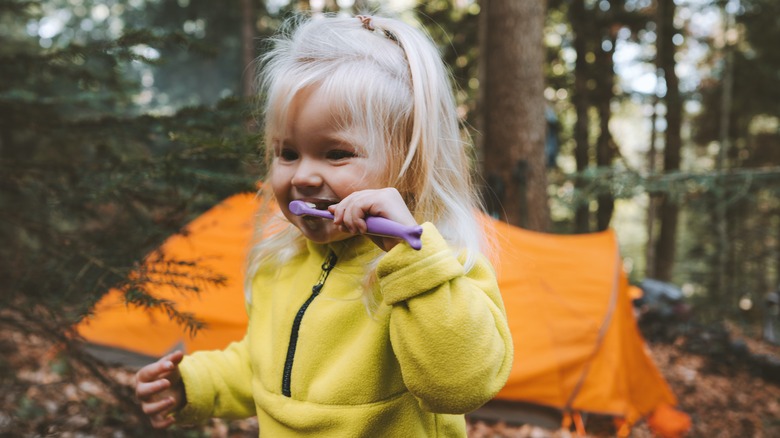12 Essential Tips For Going To The Bathroom In The Wilderness
Responsible wilderness bathroom etiquette is an essential aspect of outdoor exploration that often goes unaddressed. Nature, in all its glory, is unpredictable, and part of that unpredictability is the urgency of answering nature's call. Whether you're hiking a remote trail, camping beneath the star-lit sky, or navigating rugged terrains, the call may come when least expected. Don't fret — we'll help you prepare for these spontaneous moments — equipping you with the knowledge and skills needed to respond promptly and responsibly. Beyond those urgent calls, we'll also address basic hygienic routines (that suddenly don't seem so basic) while in the wilderness.
Responsible exploration lies at the heart of our outdoor adventures. As we revel in the beauty of nature, it becomes our shared responsibility to ensure its preservation. So, let's embark on this educational voyage, embracing the outdoors responsibly, and ensuring that the beauty of nature remains untouched for generations to come.
Location matters
In the realm of responsible wilderness bathroom etiquette, the significance of choosing the right location cannot be overstated. Our decisions in this regard reverberate through the ecosystem, impacting water sources, terrain stability, and the delicate balance of wildlife habitats.
The first imperative principle is be aware of any specific regulations or guidelines for waste disposal in the area where you are camping or hiking. Some wilderness areas may have specific rules regarding human waste. Once you're in the clear, select a spot for waste disposal at least 200 feet away from water sources, according to REI. Why this distance? Water bodies, whether a gentle stream or a pristine lake, are vital arteries of the wilderness. By maintaining a respectful distance, we safeguard these sources from potential contamination. Human waste, rich in bacteria and pathogens, poses a threat to water quality. Ensuring a buffer of 200 feet minimizes this risk, preserving the purity of water for aquatic life, wildlife, and fellow outdoor enthusiasts.
Our responsibility extends beyond water sources to the very ground beneath our feet. The terrain we choose for answering nature's call plays a pivotal role in the overall impact. In rocky or hard ground, digging a proper cat hole might be, well, harder. Conversely, in softer ground, the potential for erosion is heightened, necessitating a balance between efficiency and environmental care. By considering the terrain, we tailor our actions to minimize ecological impact, fostering a coexistence that respects the intricacies of nature. REI suggests loose, rich soil, and a site that is sunny — this will help air out or evaporate the waste-ridden area faster.
Use a trowel to dig a cat hole
Introducing a crucial tool in responsible outdoor bathroom etiquette — the lightweight trowel. Carrying a compact, lightweight trowel is not merely an accessory; it's a commitment to Leave No Trace principles and an investment in minimizing our environmental impact.
The benefits extend beyond convenience; they encompass a conscientious effort to leave the wilderness as pristine as we found it. For those who have never gone in the wilderness before, Philip Werner from Section Hiker explains how. Begin by positioning the trowel at a 45-degree angle to the ground, creating a V-shaped hole. With a firm grip, dig the hole to a depth of at least 6-8 inches. This depth is crucial for several reasons — it ensures proper waste coverage, accelerates decomposition, and minimizes the risk of waste resurfacing due to erosion or animal activity (via OSMEtv). By adhering to these guidelines, we contribute to the preservation of the wilderness, fostering a shared commitment to responsible outdoor exploration.
Use eco-friendly toilet paper tactics
Toilet paper, an essential companion in the outdoors, demands a strategic approach that aligns with our Traditional toilet paper can take a considerable amount of time to decompose, leaving a lasting impact on the environment. Biodegradable options, on the other hand, break down more swiftly, ensuring a minimal footprint on the wilderness. This simple switch underscores our commitment to responsible exploration.
Instead of toilet paper, which can tear apart, many hikers opt to use wet wipes. While convenient, many wet wipes are not biodegradable, contributing to environmental degradation or threatening wildlife who may chew on leftover wipe. Their persistence in the environment raises concerns about long-term impact. In the face of the wet wipes dilemma, we advocate for alternatives that balance convenience with environmental consciousness. Biodegradable wipes present a viable option, offering the same functionality without the lasting environmental impact.
Alternatively, opting for regular toilet paper and packing out used paper in a sealable bag ensures that our outdoor excursions do not leave behind a lasting trace. Making informed choices empowers us to minimize our ecological footprint and actively contribute to the preservation of the wilderness we cherish.
Cover your waste
Once we have judiciously selected an appropriate location for our waste disposal, a step of paramount importance follows — the meticulous covering process. This deliberate act of concealing the cat hole is not just a routine procedure; rather, it is an important waste disposal practice. Firstly, it plays a pivotal role in expediting the decomposition of waste by fostering microbial activity within the soil. This acceleration is key to minimizing the ecological impact of human waste on the natural surroundings.
Beyond its decomposition-enhancing function, the covering process also contributes significantly to the aesthetic preservation of the wilderness. By seamlessly blending the cat hole with its natural surroundings, it mitigates the visual impact on the landscape, ensuring that the pristine beauty of the environment remains unmarred.
Concealing the scent of waste through the careful layering of soil and natural materials helps mitigate any attraction or disruption that might be caused to local fauna. This aspect of responsible waste disposal is particularly crucial in preserving the natural behaviors and habitats of wildlife, fostering a harmonious coexistence between outdoor enthusiasts and the diverse ecosystems they traverse. Moreover, the covering process extends its benefits beyond the realm of environmental conservation. It also acts as a considerate measure towards fellow campers, hikers, or passersby. This thoughtful gesture contributes to a positive outdoor experience for all, emphasizing the importance of communal responsibility in the shared use of natural spaces.
Consider portable toilets
Extended trips into the wilderness demand thoughtful planning, and portable toilets have become an integral part of that planning process. The traditional methods of cat hole digging might not be practical for longer durations, making portable toilets a viable alternative.
One of the standout features of portable toilets lies in their eco-friendly design. Unlike conventional waste disposal methods that might impact the environment, portable toilets utilize containment systems that allow for the proper disposal of waste without harming the surrounding ecosystem. These units provide a designated and clean space for answering nature's call, enhancing the overall comfort of outdoor excursions.
In addition, their convenient setup and ease of use, help the modern hiker tend to their bodily needs without posing too much of a hassle from the adventure. By embracing portable toilets, we actively contribute to the conservation of pristine natural areas, leaving them unspoiled for future generations.
Pack easy hygiene essentials
In the vast expanse of the wilderness, where the beauty of untouched landscapes unfolds, the responsibility to maintain hygiene transcends mere personal care; it becomes a sacred duty owed to both ourselves and the ecosystems we explore. Hand sanitizer or biodegradable soap not only facilitate effective hand cleaning but also adhere to the principles of Leave No Trace.
While the necessity of hand hygiene is unquestionable, where and how we wash our hands matters profoundly. We must be vigilant that any waste, soap, or sanitizer residue does not embark on a journey of its own into rivers, streams, or lakes. Try to wash hands away from these water sources. This approach mitigates the potential impact on aquatic life and preserves the pristine quality of these water bodies for all living organisms. As well, for any other hikers who may be using water systems for their own hydration needs, this mitigates the potential of contamination for them.
Leave no trace, period
Just as nature calls, so does the biological process of menstruation. First and foremost, careful planning contributes to a smoother and more comfortable outdoor experience. It may be possible to plan hikes or outdoor trips around our cycles, so that excursions do not fall on menstruating days. Of course, this isn't always the case, and so preparation not only ensures personal well-being but also aligns with the overarching principle of minimizing our impact on the environment.
If you believe there's a chance Aunt Flow might visit you while you are on an outdoor excursion, be sure to pack sufficient menstrual products for the duration of their trip. Consider environmentally friendly options, such as reusable menstrual products, like cups, which reduce waste. In these cases, follow the same techniques as you would if you were emptying other bodily waste. Use water to clean your menstrual product as well as your hands before reinserting or re-wearing.
However, reusable items aren't always one's first choice. When using disposable products, bring leak-proof, sealable bags for discreet and sanitary disposal, ensuring that no trace of these products remains in the wilderness. Apply Leave No Trace principles to menstrual waste or used products, and try to pack out with you so as not to leave any environmental impact.
Respect wildlife
One of the exciting aspects of spending time outdoors is interacting with local wildlife. While we may be inclined to walk toward or touch animals we cross paths with, it is important to use discretion and maintain a quiet demeanor when an animal is nearby — especially during nature's call. Wildlife is sensitive to human presence, and minimizing our impact ensures that animals are not unduly disturbed. Being discreet contributes to a positive coexistence with the wild inhabitants.
By treading lightly, keeping a respectful distance, and avoiding sudden movements or loud noises, we reduce stress on wildlife and allow them to maintain their natural behaviors undisturbed. The same goes in the opposite direction. No one wants an unexpected surprise while tending to our bodily needs, so by preserving a peaceful environment for our animal neighbors, they are more likely to do the same for us. By incorporating these practices, we not only show consideration for wildlife but also enhance our own connection with the natural world.
Pack it out
The simple yet powerful practice of "packing out" takes center stage in preserving the pristine beauty of our wilderness. Specifically, the responsible disposal of used toilet paper and hygiene products becomes a pivotal action with far-reaching consequences.
Seemingly inconspicuous items can leave enduring traces if not handled conscientiously, emphasizing the importance of aligning our actions with the Leave No Trace principles. The act of "packing out" takes on added significance as it directly addresses the potential harm caused by improperly discarded waste, safeguarding the delicate balance of ecosystems and protecting wildlife. By consciously choosing to pack out our waste and adopting responsible disposal practices, we actively contribute to the preservation of the natural world. This commitment, grounded in environmental consciousness, prompts a heightened awareness of our impact on the wilderness.
Through practical steps, like using sealable bags for discreet disposal, "packing out" becomes a tangible and effective means of implementing positive change. It is a collective responsibility, a shared commitment to nature, ensuring that our outdoor endeavors leave behind only the echoes of our footsteps and cherished memories, preserving the enduring beauty of the wilderness for generations to come.
Dealing with digestive discomfort
Nature's call, while often serene, can occasionally present unexpected challenges. Despite our best preparations, unexpected challenges may arise during outdoor adventures. These challenges can range from digestive discomfort to food-related issues, and it's crucial to approach them with resilience and preparedness.
Factors like improper food handling or storage can contribute to food poisoning. First, it is important that adventurers engage in safe food practices, to mitigate the risk of food-borne illnesses. Prepare meals carefully and choose ingredients wisely, focusing on items less likely to perish or be contaminated, like nuts or cereals.
Sometimes, despite our best efforts, bouts of diarrhea or vomiting can disrupt the tranquility of outdoor experiences. Though it can be hard to remember when in pain or discomfort, avoid emptying into or near water sources. Dig cat holes swiftly and thought it may be challenging, still adhere to proper waste disposal. If you're lucky enough to have a family member or close friend on your trip, have them help you dig your cat hole, if you're unable to do so yourself. If your symptoms persist, be sure to rest, and take over-the-counter medication to alleviate urgency and pain.
Bathing and showering in the wilderness
While immersing ourselves in the wilderness for longer periods of time, visiting the bathroom extends beyond defecation, and into basic hygiene. If you are someone who enjoys bathing in natural water sources, be sure to choose water sources that are moving, like rivers or streams. This will reduce the risk of contracting diseases for yourself, as well as passing along contaminants, ensuring that personal hygiene practices do not compromise the purity of essential water bodies.
Some may even create a makeshift shower area in the woods. If you are, be sure to choose a location that will allow for easy dispersion of water. Be mindful of the time spent bathing and the distance from water sources. Prolonged bathing in one spot can lead to soil erosion, so it's essential to limit the duration and spread the impact over a larger area. With this method, it's also important to minimize the use of soap as soap could harm the balance of the nearby ecosystem. Alternatively, consider soap-less showers or biodegradable soap, especially when bathing in pristine areas where soap residues might have a more noticeable impact.
For those who prefer quick and easier methods of cleansing bodies, try biodegradable wet wipes, which will clean your body and leave no trace.
Practicing oral hygiene outdoors
For even one-night adventures, maintaining oral hygiene is essential. Bring a compact and travel-friendly dental kit that includes a toothbrush, toothpaste, and dental floss to save space in your backpack. Store your toothbrush in a protective case or container to keep it clean and prevent it from picking up dirt or debris. Ensure your toothbrush stays dry between uses to discourage bacterial growth.
Choose biodegradable toothpaste and dental floss to minimize environmental impact. Use a minimal amount of water when brushing your teeth to conserve your water supply. Consider using a small cup to rinse your mouth, and spit into a designated "spit hole" away from water sources. Alternatively, pack oral hygiene wipes or dental wipes for a quick and waterless clean. These wipes can be a convenient option, especially in situations where water is scarce.
When brushing is absolutely out of the question, chewing sugar-free gum can help stimulate saliva production, which aids in maintaining oral health. As well, adequate hydration supports overall oral health. Water helps flush away bacteria and debris in the mouth. Drink water regularly, especially after meals, to keep your mouth clean.
